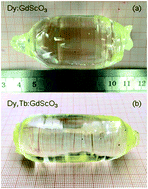Study of growth, defects and thermal and spectroscopic properties of Dy:GdScO3 and Dy,Tb:GdScO3 as promising 578 nm laser crystals
Abstract
Single crystals of Dy:GdScO3 and Dy,Tb:GdScO3 have been successfully grown by the Czochralski method. High crystalline quality of both crystals was determined via X-ray rocking curves. Effective segregation coefficients of Dy3+ and Tb3+ ions in GdScO3 host were calculated to be ∼0.7 and 1.03, respectively. The large FWHMs and absorption cross-sections of Dy:GdScO3 and Dy,Tb:GdScO3 crystals at 452 nm indicate that they can be efficiently pumped by the commercial blue GaN laser diodes. Both Dy:GdScO3 and Dy,Tb:GdScO3 exhibit relatively large stimulated emission cross-sections at 578 nm and relatively long fluorescence lifetimes. In particular, Dy,Tb:GdScO3 shows an enhanced yellow emission at around 578 nm. The energy transfer between Dy3+ and Tb3+ ions is beneficial for realizing population inversion by depopulating the population of the lower laser level of Dy3+ and has negligible influence on the upper laser level. Additionally, the defects and thermal properties of Dy:GdScO3 were investigated since they are very important for crystal growth and laser applications. Collectively, these results suggest that Dy:GdScO3 and Dy,Tb:GdScO3 can be regarded as promising candidates for realizing 578 nm laser output.



 Please wait while we load your content...
Please wait while we load your content...